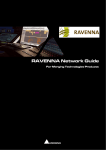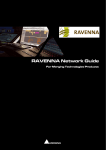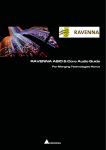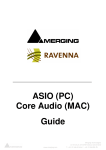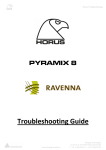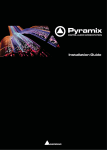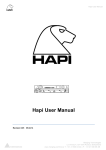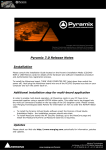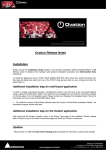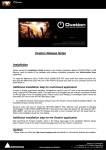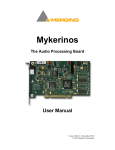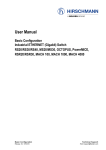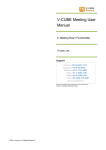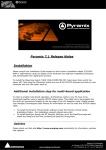Download Ravenna Network Guide
Transcript
Ravenna Network Guide For Merging Technologies Products Installation Ravenna Network Guide No part of this documentation may be reproduced in any form whatsoever or be stored in any data retrieval system without prior written permission of the copyright owners. This documentation is supplied on an as-is basis. Information contained within this documentation is subject to change at any time without notice and must not be relied upon. All company and product names are ™ or Registered Trademarks ® of their respective owners. Windows 7 is a trademark of Microsoft Corporation. Merging Technologies makes no warranties express or implied regarding this software, its quality, performance, merchantability or fitness for a particular purpose. The software is supplied “as is” you, the purchaser, are assuming the entire risk of the results of using this Merging Technologies software. In no circumstances will Merging Technologies, its owners, directors, officers, employees or agents be liable to you for any consequential, incidental or indirect loss or damages including loss of time, loss of business, loss of profits, loss of data or similar resulting from the use of or inability to use the Merging Technologies hardware and or software or for any defect in the hardware software or documentation. Product features and specifications are subject to change without notice. © Copyright Merging Technologies Inc. 2013. All rights reserved Merging Technologies Le Verney 4 1070 Puidoux Switzerland Tel: +41 21 946 04 44 Fax: +41 21 946 04 45 www.merging.com Ravenna Network Guide Ravenna Network Guide For Merging Technologies Products Contents 1 Introduction 5 Scope 5 2 Read First! 3 Introduction to Ravenna Technology 4 MT Discovery 6 7 10 Overview 10 Using MT Discovery 11 Additional Information 12 5 Merging Ravenna Easy Connect 13 Overview 13 Accessing Easy Connect 13 Additional Details 17 6 Network Switch 19 Recommended certified switch 19 Before Starting 19 Dell Power Connect 2816 Switch Auto-configuration Procedure 20 Dell Power Connect Manual Switch Configuration 30 Switch Configuration 35 Connecting Multiple Horus' to the Switch 43 7 Contacting Merging 44 International Office: 44 UK: 44 USA: 44 8 Index 45 Ravenna Network Guide : Page - 3 Ravenna Network Guide For Merging Technologies Products Document: Ravenna Network Guide rev3 Date: 15th January 2013 Ravenna Network Guide 1 Introduction RAVENNA is a solution for real-time distribution of audio and other media content in IP-based network environments. It was designed primarily by a company called ALC NetworX. RAVENNA utilizes standardized network protocols and technologies and can operate in existing network infrastructures. Performance and capacity scale with the capabilities of the underlying network architecture. For more information about Ravenna technology please see: Introduction to Ravenna Technology on page 7 and: http://ravenna.alcnetworx.com/ Scope This document contains information about Merging Technologies Ravenna systems. It has an introduction to Ravenna technology and details about the two helper applications MT Discovery and Merging Ravenna Easy Connect. There is also information about implementing more complex systems requiring a network switch. For detailed information about the Horus interface and Pyramix and Ovation software please see their specific Guides. Ravenna Network Guide : Introduction 1-5 Ravenna Network Guide 2 Read First! Important! Do not connect anything other than Ravenna devices to the Merging Technologies PCIe Ethernet Controller Card NET-MSC-GBEX1. The same applies when the connection from the card goes via the Merging certified Dell Power Connect 2816 switch. Important! Please avoid changing a network address or disconnecting Ethernet ports on your system when MassCore Ravenna is running. It is possible that this will cause your Horus connection to reset and result in gaps in your recording. Ravenna Network Guide : Read First! 2-6 Ravenna Network Guide 3 Introduction to Ravenna Technology Scope The information in this chapter is provided as background of the philosophy and technology behind Ravenna. Overview RAVENNA is a technology for real-time distribution of audio and other media content in IP-based network environments. Utilizing standardized network protocols and technologies, RAVENNA can operate on existing network infrastructures. RAVENNA is designed to meet the strict requirements of the pro audio market featuring low latency, full signal transparency and high reliability. RAVENNA is suitable for deployment in many pro audio market segments including broadcast, live sound, studios the install market and location music recording. Possible fields of application include (but are not limited to) inhouse signal distribution in broadcasting houses, theaters, concert halls and other fixed installations, flexible setups at venues and live events, OB van support, interfacility links across WAN connections and in production & recording applications. In short, it represents a new take on the third generation form of audio interconnect, where the first generation of interconnect is analogue point-to point copper, the second generation uses digital codes representing the analogue signal, conveyed point to point over copper or fibre-optic cabling and the third generation also employs digital codes representing the analogue audio but transported as packets over network infrastructure. RAVENNA is very well suited to areas where complex audio routing / mixing systems are deployed. For example; in-house distribution in broadcasting centres and WAN connections to satellite studios, OB vans, where hook up to venues with the same infra-structure becomes simple, in venues themselves for local signal distribution and connection to just such OB vehicles when required. For live events and concerts it offers highly flexible temporary installation possibilities and in theatres, opera houses and houses of worship it can provide low cost local signal distribution. Notwithstanding all of the above, RAVENNA is also an excellent candidate for relatively simple point to point interconnects such as computer to audio interface. However, RAVENNA, leaving aside the other advantages touted, is an open standard based on the ubiquitous IP protocol. Specifically, protocol levels on or above layer 3 of the OSI reference model. Since RAVENNA is purely based on layer 3 protocols, it can operate in most existing network environments. Unlike layer 1 or layer 2 solutions, it does not, in principle, require its own network infrastructure. IP can be therefore be transported on virtually any LAN and is used as the base layer for communication across WAN connections (including the internet). Although in most cases Ethernet will be deployed as the underlying data link layer, IP is in general infrastructureagnostic and can be used on virtually any network technology and topology. All the protocols and mechanisms used in RAVENNA are based on well established and commonly used methods from the IT and audio industries and comply with various standards defined and maintained by the international standards bodies. Ravenna Network Guide : Introduction to Ravenna Technology 3-7 Ravenna Network Guide A RAVENNA system requires a carefully configured IP network, a master clock device and any number of RAVENNA enabled I/O nodes. The master clock can be either a dedicated device or any RAVENNA node capable of serving as a grandmaster. The preferred time domain reference is GPS. Simple streaming across a network can be achieved without any synchronization at all but in pro audio applications tight synchronization between all devices and streams is absolutely mandatory. While playback synchronization in most applications requires sample accuracy, one goal for RAVENNA is to provide superior performance by offering phase-accurate synchronization as an option thus rendering separate reference word clock distribution throughout a facility or venue redundant. Requirements A RAVENNA node consists of a NIC (Network Interface Controller) a Media Clock which can slave to the house clock or be a master in its own right, A to D and D to A converters and a packetizer and de-packetizer each with its own sample buffer. A single node can support many audio I/O channels depending on the design. Nodes can be configured remotely across the network and concurrent unicast and multicast operation is supported. Streaming Unicast Unicast (one-to-one) is used in application scenarios such as an individual stream between two devices (e.g. a multi-channel stream between a console and a recorder/DAW). This uses a point-to-point connection between the sender and receiver. Since each additional receiver adds its own individual connection network traffic increases with every additional unicast stream. Multicast Multicast (one-to-many) streaming is used in scenarios where a single source is to be distributed to many potential recipients (e.g. program stream to journalists' desktops). At the sending end this only requires one connection per stream. Network switches are aware which participants (receivers) should receive any particular multicast and forward packets only to registered nodes. In multicast set-ups the network traffic only increases on the last (closest to receiver node) segment(s) of the network path. Infrastructure The network infrastructure must be able to transport IP packets and must support a number of standard operating protocols, e.g. RTP/RTPC for streaming since this is used widely and supports a wide variety of standard payload formats. Some of these formats are mandatory for all RAVENNA devices, others are optional. For example this protocol offers the possibility of standard media player applications subscribing to RAVENNA streams. Synchronization across all nodes is achieved via the IEEE1588-2008 (PTPv2 Precision Time Protocol). This is another standard protocol which can be used on IP. PTPv2 provides a means for synchronizing local clocks to a precision as defined in AES-11. Accurate synchronization can even be achieved across WAN connections when GPS is used as a common time domain. Quality of Service For the QoS (Quality of Service) protocol DiffServ has been chosen since it is widely supported by most modern managed switches. Since other traffic can co-exist with RAVENNA on the same network, RAVENNA traffic must be on the fast track. RAVENNA packets are assigned a high priority classification to ensure expedited transport across the network, while other packets with lower priority are treated as best-effort traffic. Even within RAVENNA there are different priorities assigned to different classes of traffic. Synchronization is assigned the highest priority, immediately followed by any real-time media traffic, while control and configuration traffic will be on a lower priority level. Any non-RAVENNA traffic would receive the lowest (standard) priority and be treated as best-effort traffic. Performance and capacity scale with the capabilities of the underlying network architecture. Ravenna Network Guide : Introduction to Ravenna Technology 3-8 Ravenna Network Guide Resilience As you would expect RAVENNA supports redundancy. Although modern network infrastructures can be configured to guarantee a high level of transport security and reliable 24/7 operation for added security there is the option of full network redundancy. Each RAVENNA device can include two independent network interfaces which can be connected to independent physical networks. By duplicating any outgoing stream to both network links, any destination device will receive the full stream data on both network interfaces independently. If data from one link is corrupted, or one network link fails completely, the uncorrupted data is still present on the other link. Changeover in the event of the failure of a network link is automatic. Basic Components Ravenna Network Basic Components Example Flexibility The system design approach allows for operation with or without centralized services for configuration / connection management. ALC NetworX recommends that basic device configuration (e.g. initial settings and setup of audio streams) should be executed via a web interface (http). However other methods may be used in addition or as an alternative. Device discovery is accomplished with DNS-SD (via an mDNS or DNS service). In small networks, without DHCP / DNS servers, the zeroconf mechanism - a fully automatic, self-configuring method - is used for auto-IP assignment and service advertisement & discovery. Streams available on the network are represented by SDP records with extended information (i.e. a clock domain identifier, RTP time stamp association etc.) Clients can connect to streams via RTSP or SDP/http Ravenna Network Guide : Introduction to Ravenna Technology 3-9 Ravenna Network Guide 4 MT Discovery Overview MT Discovery is a standalone application that searches your network(s) for Bonjour Services. It enables quick and easy access to Merging Technologies Web Services based on Bonjour, such as the Horus configuration page. These pages will be open in your computer's default browser. MT Discovery can be used to update the Horus Firmware. Please refer to the Horus User Manual for detailed information about this procedure. Note: The default web browser is determined by a computer setting, not from MT Discovery. It will most probably be one of the following applications: • Microsoft Internet Explorer • Apple Safari • Mozilla Firefox • Google Chrome. Google Chrome or Apple Safari are recommended for use with Merging Technologies products. Ravenna Network Guide : MT Discovery 4 - 10 Ravenna Network Guide Using MT Discovery Launch MTDiscovery Launch the MT Discovery application from the Windows Start Menu: All Programs > Merging Technologies > MT Discovery or by clicking on the desktop icon. MT Discovery Window The MT Discovery application window displays a tree view of all the devices it finds on the Bonjour Network. It refreshes automatically when a device is connected or disconnected. Groups MT Discovery will sort all devices into groups automatically (displayed like folders), depending on the characteristics of the devices. The different groups are: • Ravenna Devices This group contains devices which have the Ravenna protocol enabled and sorts them into different subgroups: • • Horus Devices • MassCore Devices • Asio/Core Audio Devices • Other Ravenna Devices. Emotion Servers Ravenna Network Guide : MT Discovery 4 - 11 Ravenna Network Guide • Pyramix Servers • VCube MXFix Servers • Ovation Servers • Others The Others group contains all Bonjour devices that could not be identified by MT Discovery. Printers are likely to be found in here. Note: The number in brackets near a collapsed folder indicates how many devices this folder contains. Actions Right-clicking (Ctrl+click on Mac) on an item on the tree view displays a contextual menu, which lists the actions available for the item. Open Open is what you will want to do most of the time. It will show the main page of the device in your computer's default web browser. This can also be achieved by double-clicking on a device, or by hitting Enter when the device is selected. Open Advanced Open Advanced will attempt to display the main settings page of the device in the computer's default web browser. This can also be achieved by holding down Ctrl (Cmd on Mac) and double-clicking on a device, or by hitting Ctrl + Enter (Cmd + Enter on Mac) when the device is selected. Note: Some devices will not support this, and your web browser will report a 404 - page not found error. In this case, we recommend you access the main page with command Open, described above, then browse to the setup page in your web browser directly. Expand / Collapse Only available for Groups, shows/hides the contents of a folder in the tree view. This can also be achieved by clicking on the +/- sign on the left side, or by doubleclicking on the Group name. Color Coding The color of Ravenna Device entries indicates the network they are on. Same color = same network. Device Network Color Coding Note: Horus and MassCore entries must be the same color in order to work together in Ravenna mode. Additional Information The MT Discovery application is located in the following folder: On Windows C:\Program Files\Merging Technologies\MTDiscovery On Mac TBA On Linux TBA Ravenna Network Guide : MT Discovery 4 - 12 Ravenna Network Guide 5 Merging Ravenna Easy Connect Overview The Ravenna Easy Connect utility is installed along Pyramix v8 and included in the ASIO and Core Audio Drivers package. This utility enables Horus users to connect the visible Ravenna streams and route them accordingly to the desired I/Os. Accessing Easy Connect When Pyramix is launched with the VS3 Control Panel set to Ravenna mode the Ravenna Easy Connect utility is launched automatically and appears in the Windows system tray. Users who have installed the ASIO and Core Audio Drivers will also have the utility running in the respective tray. Easy Connect Tray icon Pyramix The Ravenna Easy Connect dialog is opened by: View > Windows / Tools > Ravenna Easy Connect It can also can be opened by clicking on the Pyramix toolbar icon: Pyramix Toolbar icon Once the dialog is open the connection tree is displayed. Easy Connect will see all the Ravenna connections which are activated in the Horus module pages (as Ravenna). Ravenna Network Guide : Merging Ravenna Easy Connect 5 - 13 Ravenna Network Guide Local Computer Ravenna Host The left-hand column of the Easy Connect window shows the connections used on your MassCore system, ASIO or Core Audio host. Easy Connect Local Ravenna Hosts Network Accessible Ravenna Device The top right-hand entry in the Easy Connect window shows the available Horus units. Easy Connect Network Ravenna Device Expanding the Horus entry displays the ins (inputs) and outs (Outputs) available. These can be connected or disconnected (from drop down menu). If a Module Output Source is not set to Ravenna it will not appear in the EasyConnect Inputs and Outputs list. Easy Connect ins and outs Making a connection Click on the module to be connected. It will be highlighted once clicked. Easy Connect Selected I/O Module Ravenna Network Guide : Merging Ravenna Easy Connect 5 - 14 Ravenna Network Guide Right-click to access the drop-down context menu. Here you can connect or disconnect the module I/O. Easy Connect Context Menu Alternatively use the buttons in the lower part of the Easy Connect window to perform the connection or disconnection Easy Connect Connect & Disconnect buttons Double-clicking on a Ravenna module entry will Connect or Disconnect the module. Once the module connection is made a Green icon will be displayed Easy Connect Module Connection Ravenna Network Guide : Merging Ravenna Easy Connect 5 - 15 Ravenna Network Guide Connection Status Not connected Connected correctly Connection Error (see message displayed at bottom of Easy Connect window for details) Partial connection A Partial connection indicates that the connection to the MassCore, ASIO or Core Audio host cannot be made. Please verify that the MassCore, ASIO or Core Audio host is available in the left-hand Easy Connect column. If it is present select the problematic input or output and disconnect it, then reconnect it. If the MassCore, ASIO or Core Audio host is not present please exit and restart the application. Note: Each Input and Output module is in blocks of 8 channels (except for Monitoring which is 2 channels) Once connected the Inputs or Outputs will be available within the Pyramix Mixer for I/O connections. Activated Connection Example Once a Ravenna connection has been enabled it will be made available in the Pyramix Mixer. In the example below the AD1 input has been enabled: Easy Connect & Pyramix Connections TimeCode Connections Horus TimeCode Ravenna connections can also be enabled from Ravenna Easy Connect : Easy Connect TimeCode Connections Ravenna Network Guide : Merging Ravenna Easy Connect 5 - 16 Ravenna Network Guide Additional Details A warning red sign on the Horus logo along with a pop message will warn the user that the Horus and Pyramix project are not at the same sampling rate. Configuration error: Roll the mouse over the Horus red warning to display the exact error: Easy Connect Sampling Rate Warning Or look at the bottom of the dialog. Note: Horus and Pyramix sampling rates MUST match in order to enable I/O connections through Ravenna Easy Connect. Clear All Connections All current connections can be cleared by right-clicking on the Ravenna Easy Connect icon in the Tray to access the context menu and selecting Clear Connections. Easy Connect Tray Icon Context Menu You can also clear all connections using the button at the bottom of the Easy Connect Window: Easy Connect Clear All COnnections button This will delete all the local Ravenna connections made previously for all inputs and outputs. A confirmation popup window will appear. Click on OK to clear the connections or Cancel to abort. Ctrl + Click on the Clear All Connections button will force a delete of ALL existing Ravenna connections. Please be aware that this will clear connections that could be in use by other Ravenna hosts. Ensure that you know what you are doing. Lock to Pyramix Sampling Rate Ravenna Easy Connect also includes an option to lock the Horus to the Pyramix sampling rate. Easy Connect Sampling Rate Lock Check- When active the MassCore system will always ensure that the Horus connected to it follows its sampling rate setting. Note: When running with Ravenna ASIO and Core Audio drivers the "Locked sampling rate" option is inactive, since Horus is the sampling rate master in such a configuration Ravenna Network Guide : Merging Ravenna Easy Connect 5 - 17 Ravenna Network Guide Always on top An option to display The Ravenna Easy Connect window can be set to Always On Top in top from right-click context menu. Easy Connect Always On Top message Working with multiple Horus over a network If you have multiple Horus's in your environment they must all be connected to a Merging certified switch. Please see: Network Switch on page 19 Each Horus will then appear in your Ravenna Easy Connect utility where you will see the name of each Horus online. You will be able to make each Horus’ I/O connections with the Ravenna Easy Connect utility. Troubleshooting Sudden stoppage of Ravenna Easy Connect If the Ravenna Easy Connect utility crashes or stops simply launch it again from the Windows Start menu under: All Programs > Merging Technologies > Ravenna Easy Connect > RavennaEasyConnect Ravenna Network Guide : Merging Ravenna Easy Connect 5 - 18 Ravenna Network Guide 6 Network Switch Recommended certified switch At this time the only network switch recommended by Merging Technologies for use with Horus - Ravenna is the Dell PowerConnect 2816 and others from the same series e.g. Dell PowerConnect 2808, 2824, 2848... Dell PowerConnect 2816 Network Switch Before Starting Important! If you have problems accessing the switch for configuration when connected to the Merging MassCore PCIe Ethernet card (NET-MSC-GBEX1) please connect it to the PC’s on-board Ethernet port. When configuration is completed reconnect the switch to the MassCore Ethernet card. Important! Please avoid changing a network address or disconnecting Ethernet ports on your system when MassCore Ravenna is running. It is possible that this will cause your Horus connection to reset and result in gaps in your recording. Ravenna Network Guide : Network Switch 6 - 19 Ravenna Network Guide Dell Power Connect 2816 Switch Auto-configuration Procedure Note: For Dell Switches other than the 2816 please use the manual configuration procedure: Please see: Dell Power Connect Manual Switch Configuration on page 30 1. Right click on the Network icon in the Windows Task Bar: 2. Select: Open Network and Sharing Center 3. Click on: Change Adapter Settings on the left of the pane. Control panel > network and Internet > Network Connection Ravenna Network Guide : Network Switch 6 - 20 Ravenna Network Guide 4. Right-click the Merging Technologies PCIe 8257 Ravenna Network Card and select Properties: Local Area Connection Properties Ravenna Network Guide : Network Switch 6 - 21 Ravenna Network Guide 5. Select Internet Protocol Version 4 (TCP/IP) and Click on Properties: Internet Protocol Version 4 (TCP/IPv4) Properties 6. Click on the Use the following IP address: radio button and enter 192.168.2.2 (the DELL PowerConnect 28xx switch has a factory default IP address of 192.168.2.1). Click on the OK button to accept the settings and close the dialog. 7. Before connecting to the switch it must be put into Managed Mode since the factory default is non-managed mode. To change the switch to Managed Mode, use a paper clip to press the Managed Mode button through the small hole as indicated by the arrow in the image below: Dell PowerConnect 2816 Gigabit Managed Switch Ravenna Network Guide : Network Switch 6 - 22 Ravenna Network Guide 8. Open a browser and type 192.168.2.1 in the address bar, username: "admin" password: "admin", Click on the OK button to log in: Dell OpenManage Switch Administrator Log In Screen Ravenna Network Guide : Network Switch 6 - 23 Ravenna Network Guide The Restore Saved Configuration page will open: Dell OpenManage Switch Administrator Restore Saved Configuration Screen 9. Click on the Apply Changes button The device will reset" message will appear. Click on the OK button and wait for around 2 minutes: Message Box Ravenna Network Guide : Network Switch 6 - 24 Ravenna Network Guide 10. Log in again (username: admin password: admin) as in step 9. above. Dell OpenManage Switch Administrator Log In Screen 11. Download the latest Dell Switch Configuration file named MT Ravenna DPC2816_startup-config_1.x.ber available here: http://www.merging.com/horus/download The Merging Ravenna configuration file will auto-configures various settings /protocols to optimize the Ravenna network, and also sets the definitive fixed IP address of the switch: 169.254.252.1). Ravenna Network Guide : Network Switch 6 - 25 Ravenna Network Guide 12. After login choose System > File Management > File Download Dell OpenManage Switch Administrator File Download page 13. Select the Configuration Download and Download via HTTP radio buttons. (Arrowed in the screenshot above.) Click Choose File and browse to the MTRavenna_DPC2816_startup-config_1.x.ber file. Then click Apply Changes. Ravenna Network Guide : Network Switch 6 - 26 Ravenna Network Guide Dell OpenManage Switch Administrator File Copy message 14. When the download completes, Copy Finished, click Close. The message box below will open: Message Box 15. The downloaded configuration will be activated after reseting the device Click OK Ravenna Network Guide : Network Switch 6 - 27 Ravenna Network Guide 16. Log out Dell OpenManage Switch Administrator Log Out message Next operation is to restore the Merging Ravenna Network Card's IP configuration back to automatic (auto configured IP addresses are in the range 169.254.x.x, range on which the switch is now configured). 17. In the Network Connections window (see steps 4. 5. and 6. above), right-click the Merging Technologies PCIe 8257 Ravenna Network Card and select Properties select the Obtain an IP address automatically radio button and also select Obtain DNS server address automatically, click on OK. Internet Protocol Version 4 (TCP/IPv4) Properties Ravenna Network Guide : Network Switch 6 - 28 Ravenna Network Guide 18. The switch is now configured and ready to use, and the Merging Ravenna Network Card should have autoconfigured itself with an IP in the 169.254.x.x range. You can verify this by opening a browser and typing 168.254.252.1 in the address bar, Log in (username: admin password: admin). Dell OpenManage Switch Administrator Log In Screen 19. The switch is ready and accessible at 169.254.252.1 Dell OpenManage Switch Administrator Home Screen Ravenna Network Guide : Network Switch 6 - 29 Ravenna Network Guide Dell Power Connect Manual Switch Configuration First, connect the switch to the RJ45 port on the MassCore PCIe Ethernet card (NET-MSC-GBEX1). Configure Network Addressing The Dell PowerConnect 2816 switch comes with a factory default fixed IP of 192.168.2.1. So in order to access the switch's web user interface we first need to set the Merging network card to a fixed IP on the same subnet as the switch. 1. Open the Windows Control Panel and open the Network and Sharing Center. 2. Select Change adapter settings 3. Locate and select the Merging Technologies PCIe Ethernet card connection and Right-click on it. 4. Select properties from the drop-down menu to open the Local Area Connection Properties dialog: Local Area Connection Properties dialog 5. The networking tab should already have been configured as in the above screen shot by the Pyramix install. If this is not the case, please configure the card as seen above. Ravenna Network Guide : Network Switch 6 - 30 Ravenna Network Guide 6. Select Internet Protocol Version 4 (TCP/IPv4) to select it and click on Properties to open the properties dialog , Internet Protocol Version 4 (TCP/IPv4) Properties dialog 7. Choose the Use the following IP address: radio button. 8. Set the IP address: to 192 : 168 . 2 . 2 9. Set the Subnet mask: to 255 : 255 : 255 . 0 10. Click on OK to accept the settings and close the dialogue. Repeat to accept the settings and close the Local Area Connection Properties dialog. Configure the Switch 1. To access the switch with a browser, the switch needs to be in Managed Mode. If the Managed Mode LED on the front panel of the switch is not lit, use a paper clip to press the Managed Mode button through the small hole on the front right of the switch. Once the Managed Mode led is lit, the switch offers a web gui. It is also possible to configure the switch using the 9-pin serial connection at the back of the switch. If this is how you want to configure it, please refer to the switch's documentation. 2. Open a Web Browser (Internet Explorer is recommended for this configuration process.) 3. Enter http://192.168.2.1 in the address bar and hit Return to access the Switch. 4. Login using the default credentials: user: admin password: admin (Depending on the exact switch this field may need to be left blank. If in doubt consult the Dell 2816 Switch user guide.) Note: If you cannot access the Switch remotely perform a reset to default factory settings. On the Dell Power Connect use a paper clip and press and hold for around ten seconds the button accessed via the small hole labeled Managed Mode to the right of the RJ-45 connectors. Afterwards make sure the indicator light Managed Mode to the left of Ravenna Network Guide : Network Switch 6 - 31 Ravenna Network Guide the RJ-45 connectors is lit in order to access and configure the switch. (Press the button once again briefly if necessary.) Repeat the reset procedure in the future if remote access does not work first time. It may take two or three minutes for the switch to become available after a reset. Restore Saved Configuration dialog 5. Click on Apply Changes 6. Once logged into the switch select Change Configuration. Note: The switch will then reboot (taking 2-3 minutes to do so) In the left-hand pane click on System > IP addressing to expand it and click on IP Interface parameters Dell IP Addressing > IP Interface Parameters page 7. Set the IP Address to 169.254.252.1 see screen shot above. Ravenna Network Guide : Network Switch 6 - 32 Ravenna Network Guide 8. Click on Apply Changes. The connection to the switch will then be lost since the Merging Network card still has a fixed IP in a different range. Continue with points 9 to 12 to put the card back in IP auto-configure mode. 9. Open the Windows Control Panel and open the Network and Sharing Center. 10. Select Change adapter settings 11. Locate and select the Merging Technologies PCIe Ethernet card connection and Right-click on it. 12. Select properties from the drop-down menu to open the Local Area Connection Properties dialog: Local Area Connection Properties dialog Ravenna Network Guide : Network Switch 6 - 33 Ravenna Network Guide 13. Select Internet Protocol Version 4 (TCP/IPv4) to select it and click on Properties to open the properties dialog: Internet Protocol Version 4 (TCP/IPv4) Properties dialog 14. This time choose the Obtain an IP address automatically radio button. 15. Click on OK to accept the settings and close the dialogue. Repeat to accept the settings and close the Local Area Connection Properties dialog. Switch IP address Now you can log into the switch using http://169. 254. 252.1 Note: If you cannot access the switch once it is set to Obtain an IP address automatically try setting the adaptor to 169.254.252.2 and retry. Ensure that after configuring the switch the setting is changed back to Obtain an IP address automatically. Ravenna Network Guide : Network Switch 6 - 34 Ravenna Network Guide Switch Configuration The following steps will help you to configure the Switch for dedicated Ravenna networking. First ensure you can access and log on to the Switch. 1. Open the System > DHCP server > DHCP Server Properties page: Dell DHCP Server > DHCP Properties page 2. Set the parameters as in the screen shot above. 3. Click on Apply Changes. Ravenna Network Guide : Network Switch 6 - 35 Ravenna Network Guide 4. Open the Switch > Ports > Port Configuration page and select Show All: Dell Switch > Ports > Port Configuration page 5. Set all the Flow Control entries to Disable: Dell Switch > Ports > Port Configuration Table This setting minimizes latency on the Ravenna Network. Ravenna Network Guide : Network Switch 6 - 36 Ravenna Network Guide 6. Open the Switch > Ports > Spanning Tree > STP Port Settings page: Dell Switch > Ports > Spanning Tree > STP Port Settings page Ravenna Network Guide : Network Switch 6 - 37 Ravenna Network Guide 7. Click on Show All Dell Switch > Ports > Spanning Tree > STP Port Settings: Show All: STP Port Table 8. In the STP Port Table window, check all Fast Link check boxes as shown in the screen shot above. Note: Please ignore the 4 numeric entries in the Path Cost column and the Port State entries since these are derived from your current connection so these values may vary. 9. Click on Apply Changes. Ravenna Network Guide : Network Switch 6 - 38 Ravenna Network Guide 10. Open the Switch > Multicast Support > Global Parameters page. Dell Switch > Multicast Support > IGMP Snooping page 11. Set both drop-downs to Enable as in the screen shot above. Ravenna Network Guide : Network Switch 6 - 39 Ravenna Network Guide 12. Open the Switch > Multicast Support > IGMP Snooping page: Dell Switch > Multicast Support > IGMP Snooping page 13. Configure IGM Snooping as in the screen shot above. Querier IP Address needs to be the fixed IP address of the switch itself. 14. Click on Apply Changes. Ravenna Network Guide : Network Switch 6 - 40 Ravenna Network Guide 15. Open the Quality of Service > CoS Global Parameters > CoS Settings page: Dell Switch > Quality of Service > CoS Global Parameters > CoS Settings 16. Configure CoS settings as in the screen shot above. 17. Click on Apply Changes. Ravenna Network Guide : Network Switch 6 - 41 Ravenna Network Guide 18. Open the Quality of Service > DSCP to Queue Mapping page: Dell Switch > Quality of Service > DSCP to Queue Mapping page 19. Configure DSCP to Queue Mapping as in the screen shot above. 20. Click on Apply Changes. 21. Log out of the switch which is now configured properly. Ravenna Network Guide : Network Switch 6 - 42 Ravenna Network Guide Connecting Multiple Horus' to the Switch Once the switch is configured everything is prepared for connecting multiple Horus' to the switch ports. 1. Connect an RJ45 Ethernet patch cable (CAT5E or 6 STP) from the Merging PCIe Ethernet card (NET-MSCGBEX1) to the switch. 2. Connect an RJ45 Ethernet patch cable (CAT5E or 6 STP) from each of your Horus devices Pri (primary) port to ports on the Switch. 3. Once you power up the Horus’ one of the Horus’ will automatically be chosen as Master PTP and the other Horus’ will be PTP Slaves. Note: When several Horus’ are on the same network then one of them will be elevated automatically to PTP Master and the others configured as PTP slaves (see Horus User Manual). 4. You are now ready to work in Ravenna mode. Note: PTP sync does not permit synchronization to word clock or an audio input. However, this is not an issue since all Horus' will be synchronous. Only one Horus can lock to an external source; it then becomes the PTP master; other Horus’ switch automatically to PTP slave (see Horus User Manual). Ravenna Network Guide : Network Switch 6 - 43 Ravenna Network Guide 7 Contacting Merging International Office: Merging Technologies S.A. Le Verney 4 CH-1070 Puidoux Switzerland Phone: +41 21 946 0444 Fax: +41 21 946 0445 UK: Merging UK St Clare House, St Clare Business Park Holly Road, Hampton Hill Middx UK TW12 1QQ Phone: +44 (0) 20 894 16547 Fax: +44 (0) 870 1231747 USA: Merging USA (Independent Audio) 43 Deerfield Road Portland, ME 04101-1805 United States of America Phone: +1 (207) 773 2424 Fax: +1 (207) 773 2422 For all documentation inquiries or suggestions for improvement: http://www.merging.com Ravenna Network Guide : Contacting Merging 7 - 44 Ravenna Network Guide Index C N Connecting Multiple Horus’ to the Switch Contacting Merging 44 CoS Settings 41 43 Network Switch 19 Q D Quality of Service DHCP Server Properties 35 DSCP to Queue Mapping 42 R 8 Ravenna Technology 7 Recommended certified switch E 19 S Easy Connect 13 Accessing 13 Activated Connection Example 16 Additional Details 17 Always on top 18 Connection Status 16 Local Computer Ravenna Host 14 Lock to Pyramix Sampling Rate 17 Making a connection 14 multiple Horus 18 Network Accessible Ravenna Device TimeCode Connections 16 Troubleshooting 18 STP Port Settings 37 T TimeCode Connections 16 14 I IGMP Snooping 40 Internet Protocol Version 4 (TCP/IPv4) 31, Introduction 5 Introduction to Ravenna Technology 7 IP addressing 32 34 L Local Area Connection Properties 30, 33 M Merging Ravenna Easy Connect MT Discovery 10 Actions 12 Additional Information Color Coding 12 Groups 11 Overview 10 Using 11 13 12 Page 45













































